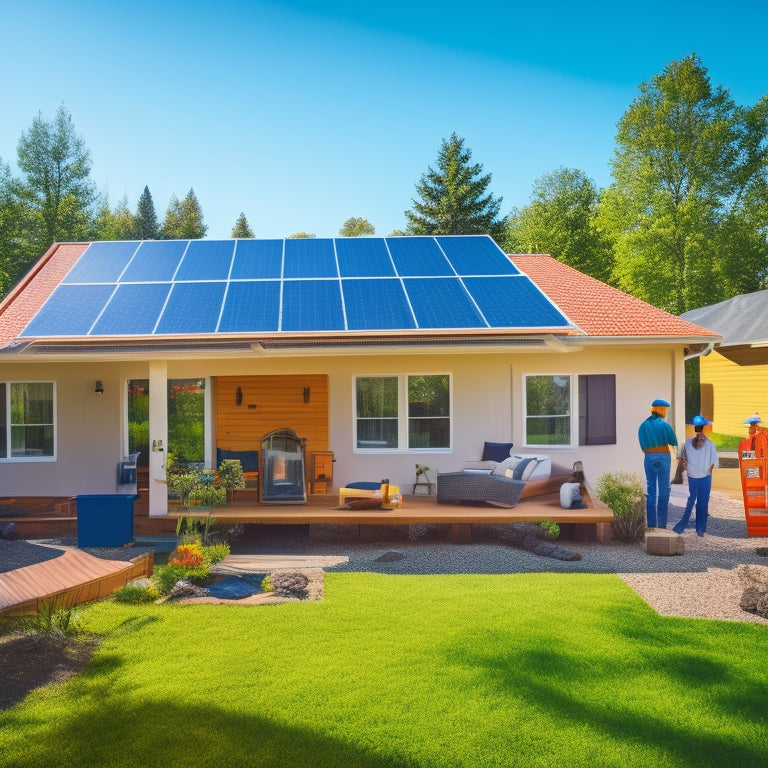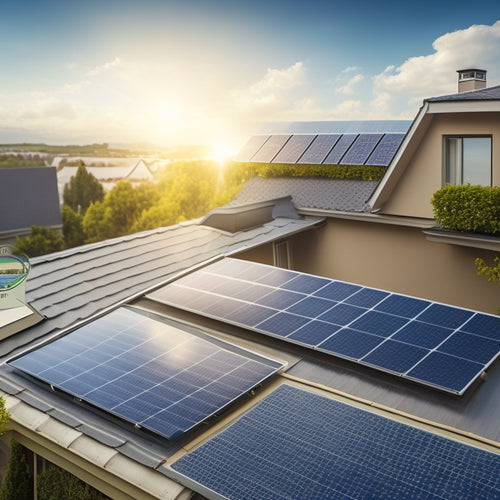
7 Essential Tips for Home Solar Panel Installation
Share
You're about to invest in a home solar panel installation, and it's important to get it right. First, assess your home's energy needs by calculating your average daily energy consumption and evaluating your energy usage patterns. Next, choose the right solar panel type based on your needs and budget. Make sure your roof is suitable, then optimize your system's performance with monitoring tools and performance tuning. Consider battery backup options, research local building codes, and work with a reputable installer. By following these essential tips, you'll be well on your way to a successful installation - and there's more to discover when it comes to maximizing your solar panel's potential.
Key Takeaways
• Calculate your home's average daily energy consumption to determine the required solar panel capacity.
• Conduct an energy audit to identify areas of energy inefficiency and optimize energy usage patterns.
• Choose the right type of solar panel based on your budget, energy needs, and roof space.
• Ensure your roof is structurally sound and has enough unobstructed space to accommodate the solar panels.
• Research and comply with local building codes, zoning regulations, and permitting processes to avoid costly rework or removal.
Assess Your Home's Energy Needs
To determine the size and type of solar panel system you'll need, you must first calculate your home's average daily energy consumption in kilowatt-hours (kWh). This involves conducting an energy audit to identify areas of energy inefficiency and opportunities for improvement. By evaluating your energy usage patterns, you'll be able to determine how much energy you need to produce to power your home.
Start by gathering your past electricity bills to get an accurate picture of your energy consumption. You can also use online energy calculators or consult with a professional to help you determine your energy needs.
Look for opportunities to enhance your home's energy efficiency, such as replacing incandescent bulbs with LEDs or adding insulation to your attic. By reducing your energy consumption, you'll need a smaller solar panel system, which can save you money on upfront costs.
A thorough energy audit will help you optimize your energy usage and make sure that your solar panel system is sized correctly to meet your energy needs.
Choose the Right Solar Panel Type
With your energy needs assessment in hand, you're ready to select the ideal solar panel type that will effectively meet your energy demands. The right panel type will guarantee maximum energy production and a faster return on investment. You have three primary options: Monocrystalline, Polycrystalline, and Thin Film.
| Panel Type | Key Characteristics |
|---|---|
| Monocrystalline | High efficiency, durable, and expensive |
| Polycrystalline | Mid-range efficiency, affordable, and reliable |
| Thin Film | Low efficiency, inexpensive, and flexible |
Monocrystalline benefits include high energy output per hour and a sleek design. However, they come at a higher cost. Polycrystalline panels offer a balance between efficiency and affordability. Thin Film panels, on the other hand, are a cost-effective option, but their energy output is lower. When comparing Thin Film to other options, consider the trade-off between cost and energy production. By weighing these factors, you'll select the perfect solar panel type for your energy needs and budget.
Ensure Proper Roof Size and Condition
When preparing your home for solar panel installation, you'll need to make sure your roof is up to the task.
You'll want to assess whether your roof has sufficient space to accommodate the solar panels and whether it can support their weight.
It's also important to evaluate the structural integrity of your roof to guarantee a safe and secure installation.
Roof Space Requirements
Your roof's size and condition play a vital role in determining the feasibility of a solar panel installation, as a minimum of 100-200 square feet of unobstructed roof space is typically required to accommodate a standard residential solar panel system. This means you'll need to assess your roof's size and identify any obstacles that might impact the installation.
Roof obstacles, such as vents, skylights, and chimneys, can reduce the available space and may require additional installation costs or creative solutions.
Aesthetic considerations are also important, as solar panels should be installed in a way that blends with your roof's architecture. You'll want to make sure that the panels are positioned in a way that maintains your home's curb appeal. A well-planned installation can increase your property's value, so partnering with an experienced installer who can balance functionality with aesthetics is crucial.
Solar Panel Weight Capacity
You must verify that your roof can support the weight of solar panels, which typically range from 2-4 pounds per square foot, depending on the type and quality of the equipment. This is important to confirm that your roof can handle the additional load without compromising its structural integrity.
| Roof Type | Weight Capacity |
|---|---|
| Asphalt Shingle | 2.5-3.5 psf |
| Clay or Concrete Tile | 3-4 psf |
| Metal Roof | 2-3 psf |
| Slate Tile | 3.5-4.5 psf |
| Wood Shake | 2-3 psf |
To ensure your roof can support the weight, you may need to contemplate structural reinforcement, such as adding additional roof framing or support beams. This is especially important if you have an older roof or one that has been damaged in the past. Additionally, you should inspect your roof framing to confirm it's in good condition and can handle the added weight. By doing so, you'll guarantee a safe and successful solar panel installation.
Structural Integrity Check
Before installing solar panels, examine your roof's size and condition to confirm it can accommodate the system, taking into account factors such as age, material, and damage history. A thorough structural integrity check is essential to guarantee a safe and efficient installation.
You'll want to perform a roof age assessment to determine if your roof is nearing the end of its lifespan. A newer roof is ideal, but if your roof is older, you may need to contemplate replacing it before installing solar panels.
Additionally, verify that your roof complies with local building codes and regulations. Here are some key considerations:
-
Confirm that your roof can support the weight of the solar panels, considering the material and age of your roof.
-
Check for any signs of damage, such as cracks, leaks, or worn-out shingles, and address them before installation.
-
Ensure that your roof's framing and structure can handle the added weight and stress of the solar panel system.
Optimize Your System's Performance
As you finalize your solar panel installation, it's important to guarantee that your system operates at its best.
To achieve this, you'll need to implement measures that monitor and optimize performance.
System Monitoring Tools
Optimizing your solar panel system's performance relies heavily on the ability to accurately monitor its output. This is where system monitoring tools come into play. These tools provide you with real-time insights into your system's performance, enabling you to identify areas of improvement and maximize your energy production.
With system monitoring tools, you can:
- Track your energy production in real-time, allowing you to detect any issues or malfunctions promptly
- Access detailed energy analytics to identify patterns and trends in your energy usage
- Receive alerts and notifications when your system is underperforming, ensuring you can take corrective action quickly
Energy Efficiency Analysis
By analyzing your system's energy efficiency, you can pinpoint areas where energy losses occur and implement targeted improvements to maximize your solar panel system's overall performance. This process, known as energy auditing, helps identify opportunities to reduce your carbon footprint and optimize energy production. A thorough energy efficiency analysis involves evaluating various system components, including panel cleanliness, inverter performance, and wiring integrity.
| Energy Efficiency Factors | Optimization Strategies |
|---|---|
| Panel Cleanliness | Regular cleaning schedules to minimize debris impact |
| Inverter Performance | Upgrade to high-efficiency inverters for maximum energy harvesting |
| Wiring Integrity | Inspect and replace worn or damaged wiring to minimize energy losses |
Peak Performance Tuning
You can optimize your solar panel system's full potential by identifying and addressing performance bottlenecks through peak performance tuning. This process guarantees that your system operates at its maximum capacity, maximizing energy harvesting and reducing the likelihood of underperformance.
By fine-tuning your system, you can increase its overall efficiency, thereby reducing your reliance on the grid and minimizing your carbon footprint.
To achieve peak performance, consider the following:
-
Panel calibration: Make sure that your solar panels are properly calibrated to optimize energy output. This involves adjusting the panel's angle, tilt, and orientation to maximize energy harvesting.
-
Inverter optimization: Enhance your inverter's performance by ensuring it's properly configured and matched to your solar panel array.
-
Monitoring and maintenance: Regularly monitor your system's performance and perform routine maintenance to identify and address any potential issues before they impact energy production.
Consider Battery Backup Options
When designing your home solar panel system, incorporating a battery backup can ensure a steady supply of electricity during grid outages or periods of high energy demand. This is especially important for homeowners seeking Grid Resiliency and Energy Autonomy. A battery backup system stores excess energy generated by your solar panels during the day, allowing you to tap into it when the grid is down or during peak energy usage hours.
Here's a comparison of popular battery backup options:
| Battery Type | Capacity | Cycle Life |
|---|---|---|
| Lead-Acid | 2-4 kWh | 200-300 cycles |
| Lithium-Ion | 5-10 kWh | 3,000-5,000 cycles |
| Flow Battery | 10-100 kWh | 5,000-10,000 cycles |
| Sodium-Ion | 2-5 kWh | 1,000-2,000 cycles |
| Nickel-Cadmium | 1-2 kWh | 1,000-2,000 cycles |
When selecting a battery backup system, consider factors such as capacity, cycle life, and compatibility with your solar panel system. By incorporating a battery backup, you'll enjoy a reliable and efficient source of energy, even when the grid is down.
Research Local Building Codes
Researching and complying with your local government's specific building codes and regulations that dictate how solar panels and battery backup systems must be installed is important to avoid costly rework or even system removal.
As you prepare for your home solar panel installation, it's vital to understand the local regulations that govern the installation process.
Before you begin, take the time to research the following key areas:
Zoning regulations: Familiarize yourself with local zoning laws that may impact the placement and appearance of your solar panels.
Permitting process: Understand the necessary permits and approvals required for your installation, including electrical and building permits.
Inspections and certifications: Determine if your local government requires any special inspections or certifications for solar panel installations.
Work With a Reputable Installer
With local building codes and regulations in mind, it's time to find a reputable installer who can guarantee a seamless and compliant installation process. You'll want to research potential installers thoroughly, paying close attention to their credentials and company reputation. Look for installers certified by reputable organizations, such as the North American Board of Certified Energy Practitioners (NABCEP). This guarantees they've the necessary expertise to design and install a system that meets local building codes and maximizes energy production.
When evaluating installers, ask about their experience with residential installations, their warranty and maintenance policies, and their customer service reputation. Check online reviews, ask for referrals, and contact the Better Business Bureau to get a sense of the company's reputation.
A reputable installer will provide you with a detailed quote, including the system's specifications, installation timeline, and warranty information. Don't be afraid to ask questions or seek a second opinion if you're unsure about any aspect of the installation process.
Frequently Asked Questions
Can I Install Solar Panels on a Shady Roof?
You can install solar panels on a shady roof, but beware of roof obstructions and sunlight blockage, which reduce energy output; assess your roof's shading patterns to optimize panel placement and maximize energy production.
How Long Does a Typical Solar Panel Installation Take?
While you're excited to harness the sun's power, you're wondering how long the installation process takes. Typically, it takes 1-3 days, but be prepared for scheduling delays and weather conditions that might slow things down.
Can I Install Solar Panels Myself to Save Money?
While you might consider installing solar panels yourself to save money, be aware that DIY challenges and safety concerns abound, making it important to weigh the risks against potential cost savings before taking on the project alone.
Will Solar Panels Increase My Property Taxes?
You won't necessarily see an increase in property taxes due to solar panels, as many states offer tax exemptions for renewable energy systems, minimizing the assessment impact on your property's value.
Are Solar Panels Covered by a Warranty?
You'll be relieved to know that solar panels usually come with a warranty, covering defects and performance issues for a specific warranty period, typically 25 years, and backed by manufacturer support for peaceful operation.
Related Posts
-

5 Tips for Efficient Last Mile EV Delivery
You're looking to supercharge your last mile EV delivery operations. Start by optimizing your fleet operations to red...
-

Understanding Residential Solar Panel Installation Warranties
When you invest in a residential solar panel installation, you expect a comprehensive warranty package that covers th...
-

Why Home Battery Deals Are Worth Buying Online
You're buying a home battery deal online for the same reason you wouldn't buy a car without researching online first....


